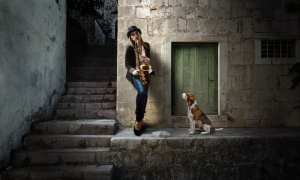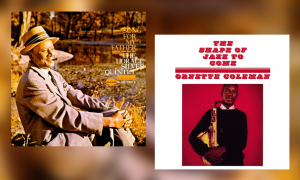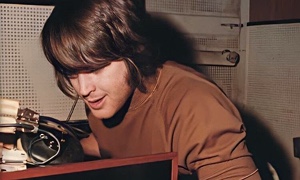Home » Jazz Articles » Building a Jazz Library » Thelonious Monk: An Alternative Top Ten Albums Of Deep A...
Thelonious Monk: An Alternative Top Ten Albums Of Deep And Staggering Genius

Courtesy David Redfern
The best thing about jazz is that it makes a person appreciate freedom. Jazz and freedom go hand in hand. That’s all there is to tell about that. That explains it. Just think about it and you’ll dig it.
—Thelonious Monk
During his lifetime, however, the course of Monk's career was as craggy as the contours of his music. Things started well in 1947, when Alfred Lion signed him to Blue Note. But five years later, unable to break Monk beyond a tiny audience of jazz musicians and cognoscenti, Lion cut his losses and let Prestige's Bob Weinstock take him on. Prestige had no more success than Blue Note, and in 1955, Riverside's Orrin Keepnews was able to buy Monk's contract from Weinstock for just $108.27.
But by 1957, Monk's time had finally arrived. Reviewers placed him in what Keepnews called "the automatic five-star category," and in 1961, Columbia lured Monk from Riverside with a deal rumoured to be almost as valuable as the one they had given to Miles Davis six years earlier. In 1964, Monk received the era's ultimate seal of establishment approval, the cover of TIME magazine. Yet in 1970, unable to find a mainstream audience for Monk, and so recoup their investment, Columbia let his contract lapse. During his few remaining years of activity, Monk moved from one small specialist label to another.
Through all of this, Monk continued to record great music, though his composing output slowed up from the mid 1960s onwards, with most albums typically containing just one new piece. As one of his obituarists observed, Monk, like the painter Paul Cézanne with his ceaseless studies of Mont St Victoire, felt no need to find fresh inspiration for his muse. He was happy to dig deep into what he already had, finding new perspectives and possibilities within it.
By the late 1970s, Monk had stopped performing. Beset by longstanding mental health issues beyond contemporary diagnosis and treatment, and which by the turn of the decade had reduced him to near catatonia, Monk moved from Manhattan into the New Jersey home of his longtime benefactor, the Rothschild heiress Baroness Pannonica De Koenigswarter. He emerged only for neighbourhood walkabouts, and eventually stopped even leaving his room. On 5 February 1982, Monk suffered a massive stroke and passed twelve days later. He was only 64 years old.
A reluctant interviewee with a penchant for epigrams—"There ain't no wrong notes on the piano," "Silence is the loudest noise," "Everybody is a genius at being themselves"—Monk was, in contemporary parlance, a "race man," that is, he believed in the equality of all races and was angered by the mistreatment of blacks by whites. And, at a time when many musicians were afraid to say as much for fear of losing their white audience, Monk did not shy away from the issue. This, along with his music, ensures his ongoing relevance. (Monk was his own man in his social views as much as his music. "When I was a kid," he once said to a journalist, "some of the guys would try to get me to hate white people for what they've been doing to Negroes, and for a while I tried real hard. But every time I got to hating them, some white guy would come along and mess the whole thing up").
In order to draw attention to some of the lesser-known treasures in Monk's discography, this Alternative Top Ten Albums selection excludes all his own-name albums for Blue Note, Prestige and Riverside, as well as the widely celebrated albums he made as a sideman with Art Blakey's The Jazz Messengers and with Miles Davis. Monk's Columbia years are often, wrongly, written off as uneventful, and three of the best of his Columbia albums are included here. The discs are listed in chronological order. Hopefully, you will find one or two that have so far escaped your attention.
 Thelonious Monk
Thelonious MonkAfter Hours At Minton's
Definitive, recorded 1941, released 2001
After Hours At Minton's was recorded at New York's bop crucible by the far-sighted jazz fiend Jerry Newman, who schlepped an acetate-cutting machine there on a succession of nights in late spring 1941. A student at Columbia University, Newman made the recordings to be broadcast on the university's Radio Club programme on WKCR. The twelve tracks on the album are not to be confused with another package of Minton's material, also recorded by Newman, which showcases guitarist Charlie Christian. Christian figures here, but the focus is on Monk. The trumpeters are Roy Eldridge and Hot Lips Page and the tenor saxophonists are Herbie Fields and Al Sears. The rhythm section is completed by bassist Nick Fenton and drummer Kenny Clarke. These are essentially straight-ahead swing tracks and Monk's style is still in its infancy—but there are hints of what was to come, both harmonically and rhythmically. For Monk aficionados, it all starts here.
 Charlie Parker & Dizzy Gillespie
Charlie Parker & Dizzy GillespieBird & Diz
Mercury, 1952
Another crucial slice of jazz history, Bird & Diz is the only known occasion when three of the founding fathers of bop—Monk, Charlie Parker and Dizzy Gillespie—recorded together. They were assembled by producer Norman Granz along with bassist Curly Russell and drummer Buddy Rich. Granz describes Monk in the sleeve notes as "a lesser light" of the music, an atypical lapse of judgement; maybe he meant that in 1952 Monk was little known outside musicians' circles, which was true. Anyway, Granz—whose sleeve notes of the period could be disarmingly frank (on the recently busted Stan Getz's 1953 Norgran album Interpretations he talks about the "weakness of the man")—also wrote that the session was "a very happy date." It certainly sounds like it. A little disappointingly from a Monk enthusiast's point of view, all eight tracks (this was originally a 10" album, later padded out with alternate takes) are Parker tunes. But everything else is just dandy.
 Thelonious Monk
Thelonious MonkPiano Solo
Swing, recorded 1954, reissued 2017
Piano Solo , Monk's first solo album, was recorded at the Club D'Essai in Paris for a radio broadcast. In the first of the horde of spelling errors that would pursue Monk throughout and beyond his life, it was credited by the French label Swing to Theolonious Monk (at least the typographer had the excuse of not having English as a first language). Sony Legacy's 2017 CD edition retitled it Paris 1954. There are seven Monk originals and a cover of Jerome Kern's "Smoke Gets In Your Eyes." The material was remastered by Sony and bundled with five tracks which Monk had recorded a few days before the D'Essai gig, in concert at the Salle Pleyel concert hall, where he was accompanied by bassist Jean-Marie Ingrand and drummer Jean-Louis Viale. Some of Monk's most enjoyable work was made solo, but his catalogue contains relatively little of it.
 Gigi Gryce
Gigi Gryce The Gigi Gryce Orchestra / The Gigi Gryce Quartet
Signal, 1955
In 1957, alto saxophonist, composer and arranger Gigi Gryce was in the band which recorded Monk's masterpiece Monk's Music (Riverside). Less radical than Monk, Gryce's own music nonetheless stretched the hard bop envelope and not for nothing was his late 1950s quintet known as The Jazz Lab. Side one of Gigi Gryce (later reissued as Nica's Tempo) is devoted to Gryce's big band, with Horace Silver on piano, and focuses on Gryce originals. Side two is billed as by the Gigi Gryce Quartet, although this was in practice a group co-led with Monk. Percy Heath is on bass and Art Blakey on drums. Three of the four tunes are Monk's—"Shuffle Boil," "Brake's Sake" and "Gallop's Gallop"— and there is one Gryce original, "Nica's Tempo," which is named after Pannonica de Koenigswarter, who was a friend and benefactor of many New York musicians during the 1950s and 1960s. More than worth having for side two alone, you will not begrudge having side one along for the ride.
 Clark Terry With Thelonious Monk
Clark Terry With Thelonious Monk In Orbit
Riverside, 1958
Another great sideman session, In Orbit was recorded after trumpeter and flugelhornist Clark Terry had guested on "Bemsha Swing" on Monk's landmark album Brilliant Corners (Riverside, 1957). Despite its use of rhythmic displacement, Monk's music always swung like crazy and its conjunction with that of the swing stylist Terry, who in his time played with both Count Basie and Duke Ellington, works well. Terry leads a quartet which is completed by bassist Sam Jones and drummer Philly Joe Jones, another irrepressibly hard swinger. Most of the tunes are Terry's but there is one Monk original, "Let's Cool One." No paradigms are shifted here, but the album is hugely enjoyable.
 Thelonious Monk
Thelonious Monk Les Liaisons Dangereuses
Sam, recorded 1960, released 2017
New wave French film director Roger Vadim's Les Liaisons Dangereuses had a soundtrack which was custom recorded by Monk. The music was not released during Monk's lifetime and the tapes from the session were lost in the vaults until 2015. Two years later, during Monk's centennial year, Sam Records released them in partnership with the Thelonious Monk Estate. Vadim had wanted Monk to score new compositions and, after sending a rough cut of the film to him in New York in advance, flew to the city to supervise the recording, accompanied by French tenor saxophonist Barney Wilen. But Monk was recovering from the mental collapse which had led to his recent, racially motivated arrest for assaulting a policeman (as in "he assaulted my nightstick with his head, your honor") and was not up to composing. So he and tenor saxophonist Charlie Rouse, bassist Sam Jones and drummer Art Taylor recorded nine mostly familiar Monk tunes. Wilen, who had previously performed with Monk in Paris, is featured on three of them, " Rhythm-a-Ning," "Crepuscule with Nellie" and "Ba-Lue Bolivar Ba-Lues-Are." He acquits himself well. Monk may have been feeling under the weather, but his muscular performance belies it.
 Thelonious Monk
Thelonious Monk Mønk
Gearbox, recorded 1963, released 2018
British audiophile label Gearbox came up with a blinder after it acquired the mastertape for this previously unissued album from the person who rescued it from a builder's skip in Copenhagen, where Monk's Quartet had recorded it at the Odd Fellow Palæet in early 1963. Despite being monophonic, Mønk's sound is among the best of Monk's live albums, the original analogue tape having been mixed and mastered by Gearbox on state of the art analogue equipment, with no digital in the path at any stage. The performance, by what some regard as Monk's strongest quartet lineup—tenor saxophonist Charlie Rouse, bassist John Ore, drummer Frankie Dunlop—is just dazzling, justifying all the attention that has been lavished on it. There are five tracks, Monk's "Bye-Ya," "Nutty" and "Monk's Dream," and two standards, George Bassman's "I'm Getting Sentimental Over You" and Johnny Green's "Body And Soul." Essential listening.
 Monk
Monk Live At The It Club Complete
Columbia, recorded 1964, released 1998
This double CD, recorded at San Francisco's It Club, may be the most important of Monk's live albums (another double, Columbia's Live At The Jazz Workshop Complete, also from 1964, runs it a close second). It is not the gritty performances—by Monk, Charlie Rouse, bassist Larry Gales and drummer Ben Riley—which make the album stand out; it is because it chronicles both nights of a Quartet club appearance in their entirety and as they unfolded (just one tune, which was torpedoed by technical problems, is edited out). This is, in effect, Monk's version of the Miles Davis Quintet's complete Friday and Saturday night performances at San Francisco's Black Hawk, recorded by Columbia in 1961. Producer Teo Macero's location tapes, which were more than good to start with, have been made even better by modern technology.
 Thelonious Monk
Thelonious Monk Underground
Columbia, 1968
Monk's last quartet album with Charlie Rouse and the last small-group album Monk recorded in the US. Five decades on, it is among the most enduring studio albums he made for Columbia, not least because it includes four previously unrecorded original compositions—"Raise Four," "Ugly Beauty," "Boo Boo's Birthday," "Green Chimneys"—the most on any Monk album for fifteen years. Don't be put off by the sleeve art, which, in a clunky attempt to co-opt the youth zeitgeist, showed Monk sitting at a beat-up upright with a rifle slung across his shoulder and a woman holding a machine gun in the background. The same year, Columbia had booked Monk into rock venues such as San Francisco's Carousel Ballroom and New York's Fillmore East. But, as he unfailingly did throughout his life, Monk resisted any pressure to compromise his artistic integrity and the marketing strategy came to nothing.
 Thelonious Sphere Monk
Thelonious Sphere MonkMonk's Blues
Columbia, 1969
Monk's final release on Columbia before the label dropped him. The album was recorded in Los Angeles with a sixteen-piece orchestra arranged and conducted by Oliver Nelson and produced by Teo Macero. Monk's road band—Charlie Rouse, Larry Gales, Ben Riley—are at the heart of things, augmented by jazz-based studio musicians from Nelson's regular stable. Aside from a couple of unremarkable Macero tunes, the material is familiar fare but given a new spin by Nelson's empathic arrangements —notably including concise versions of "Brilliant Corners" and "'Round Midnight" and longer workouts of "Straight, No Chaser" and "Rootie Tootie." At the time, no-one knew this was going to be Monk's last date for Columbia, but in the event he went out with what is arguably the most successful of his few big band projects.
Tags
PREVIOUS / NEXT
Support All About Jazz
 All About Jazz has been a pillar of jazz since 1995, championing it as an art form and, more importantly, supporting the musicians who make it. Our enduring commitment has made "AAJ" one of the most culturally important websites of its kind, read by hundreds of thousands of fans, musicians and industry figures every month.
All About Jazz has been a pillar of jazz since 1995, championing it as an art form and, more importantly, supporting the musicians who make it. Our enduring commitment has made "AAJ" one of the most culturally important websites of its kind, read by hundreds of thousands of fans, musicians and industry figures every month.





















